Discovering a hole in your carpet especially when you don’t have any leftover carpet can be frustrating. Holes can develop from heavy furniture wear, pet damage, cigarette burns, or accidental tears, and while many homeowners assume that professional replacement is the only solution, the truth is, you can often fix carpet holes yourself, even without a matching patch.
The key lies in using innovative repair methods, clever techniques, and readily available materials to restore your carpet’s appearance and prevent further damage. In this comprehensive guide, we’ll explore step-by-step methods for fixing a hole in carpet when you don’t have extra carpet, along with tools, techniques, and tips to ensure a smooth, long-lasting result.
Why Carpet Holes Happen — Common Causes
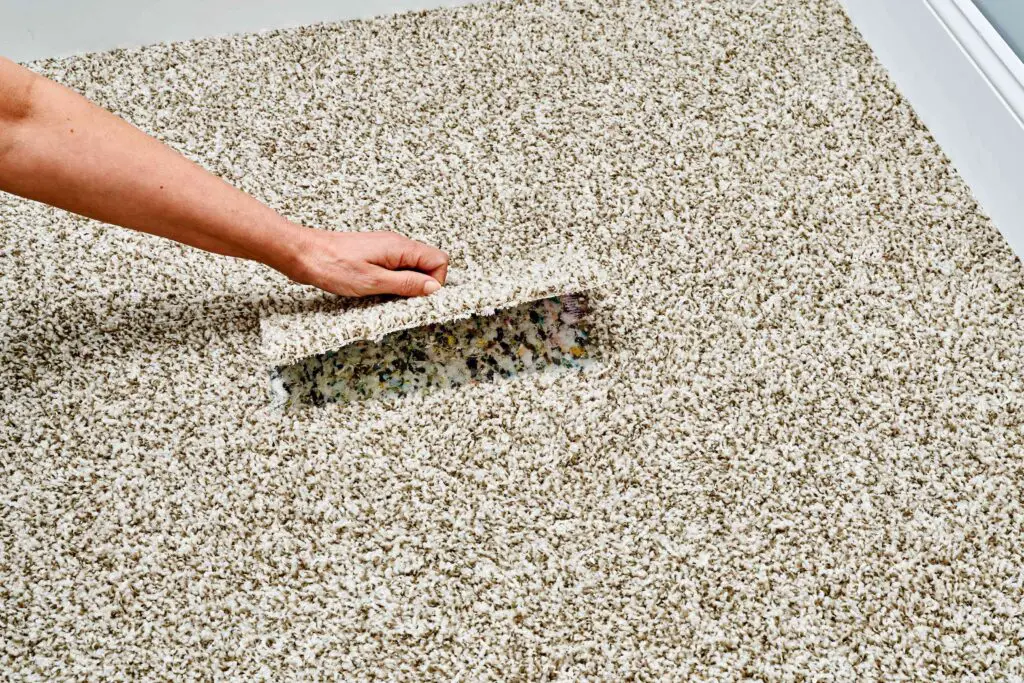
Before diving into the repair process, understanding the common reasons behind carpet holes can help you prevent future damage.
Heavy Furniture and Repetitive Pressure
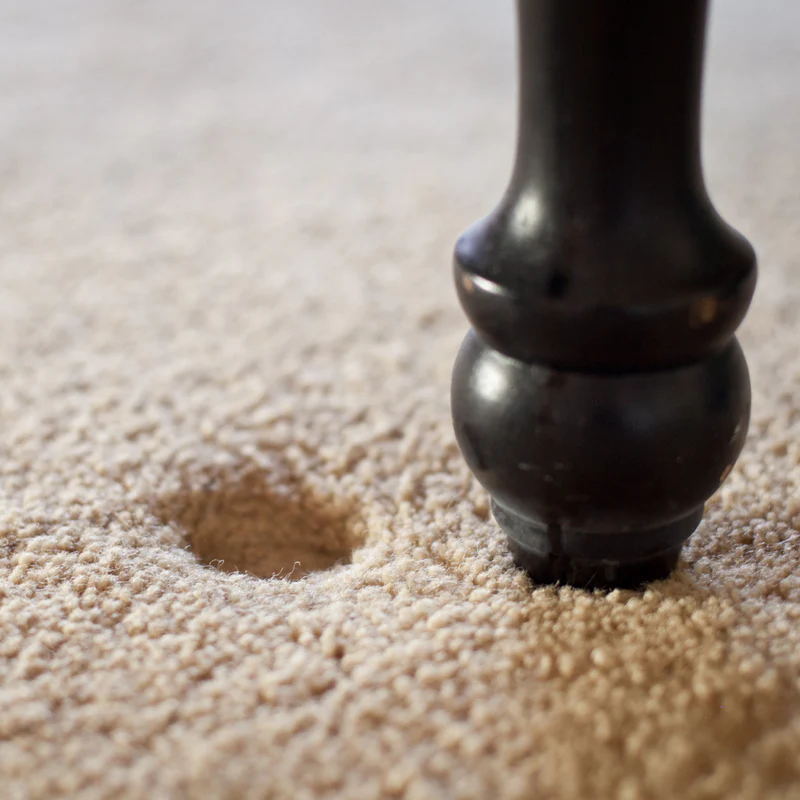
Placing heavy furniture in one spot for extended periods can lead to carpet pile compression. When that furniture is moved or dragged, it can pull and tear fibers, creating a visible hole. Additionally, constant foot traffic around furniture corners can wear down the same spots repeatedly, leading to thinning and eventual holes.
Pet-Related Damage
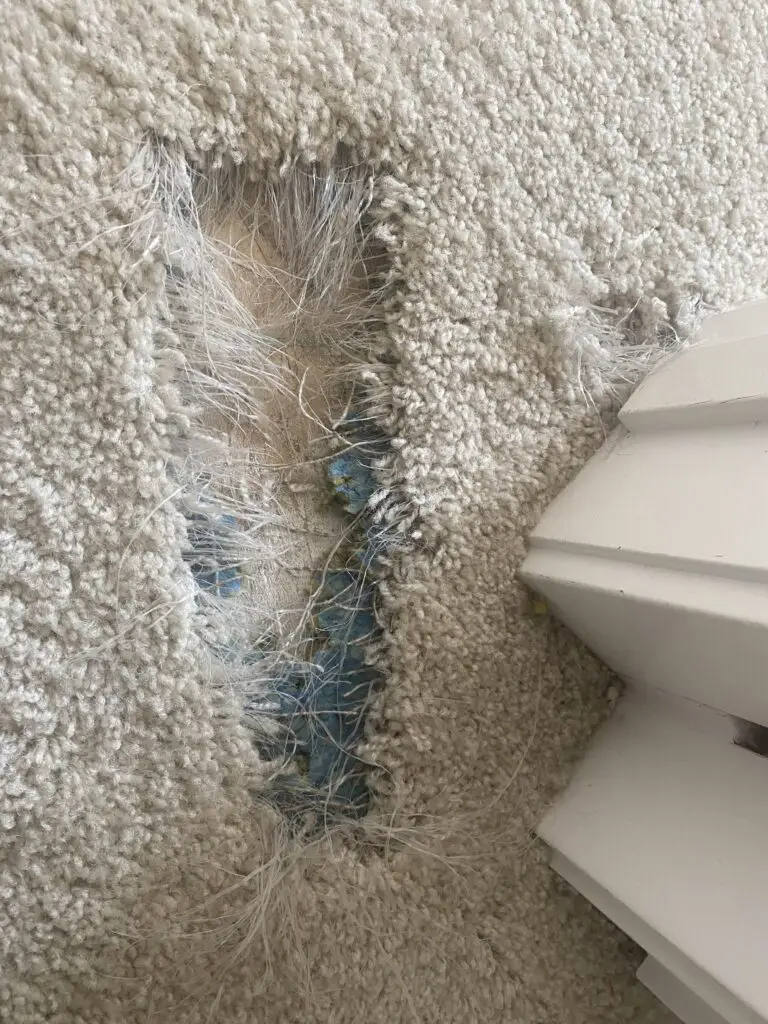
Cats and dogs are notorious for scratching, chewing, or digging at carpets, especially near doorways or under furniture. Their claws can break through the carpet fibers, and persistent digging or biting can lead to punctures or holes that gradually expand. Pet urine or vomit can also damage the carpet backing, causing weak spots that may eventually turn into holes.
Burns from Cigarettes or Hot Objects

One of the most common causes of small carpet holes is burns. A dropped cigarette, curling iron, or even a hot pan can singe the carpet and create blackened, melted holes. These burns often go deep into the carpet pile and backing, making patching necessary.
Accidental Cuts or Tears
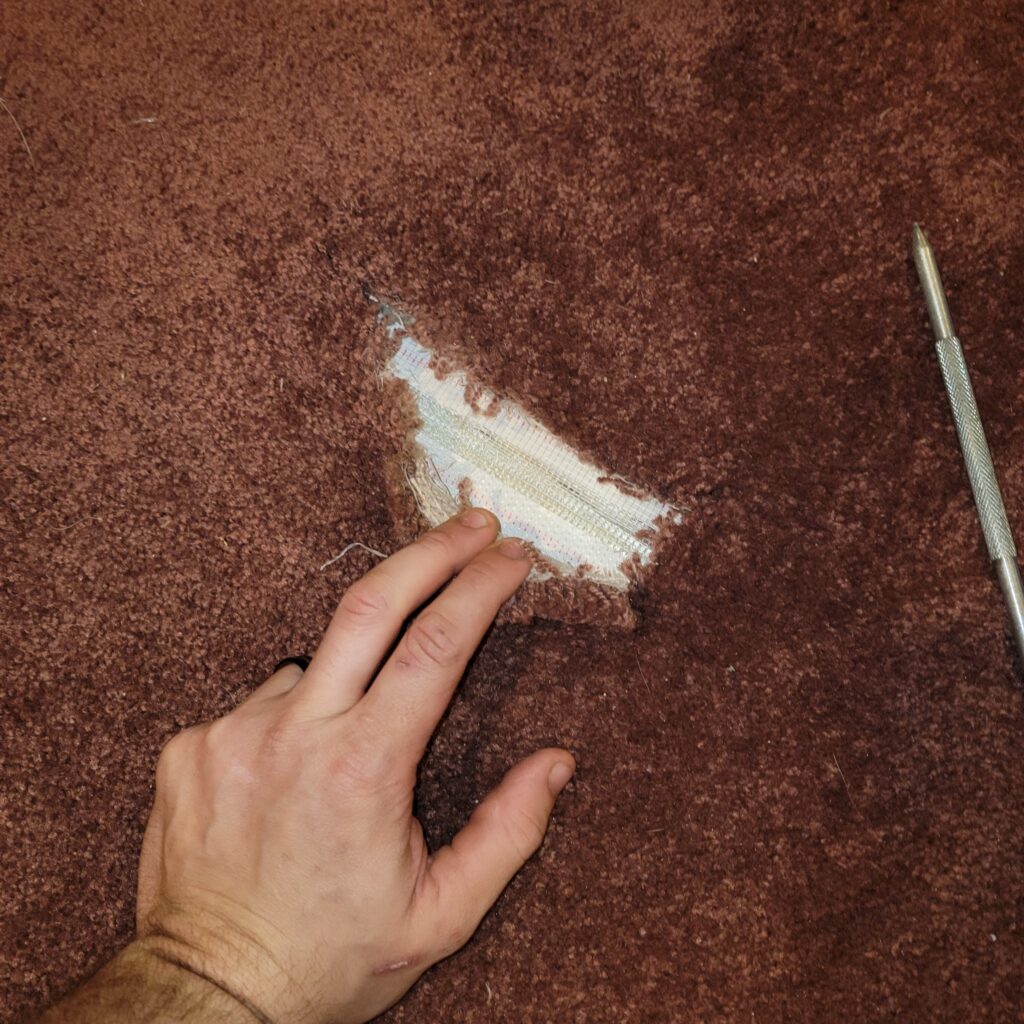
Sharp objects like scissors, knives, or broken glass can cause accidental cuts. Over time, these small slices may widen into gaping holes as the edges fray and unravel under stress. Children playing with tools or dragging heavy items across the carpet can unintentionally create such damage.
Old Age and Wear
Carpets naturally deteriorate over time. In high-traffic areas, the carpet pile wears thin and eventually exposes the backing. Weak areas can give way to holes when subjected to routine cleaning, vacuuming, or moving furniture.
Related Topic: Carpet Ripples and Buckling: Causes, Solutions & Prevention
Tools and Materials You’ll Need for Repair
Even without a spare piece of matching carpet, you can still perform a successful fix. Here’s a comprehensive list of tools and materials that may be useful depending on your chosen repair method:
- Sharp utility knife or carpet cutter
- Carpet seam roller
- Strong adhesive or hot glue gun
- Carpet patch from a hidden area (like a closet corner)
- Heavy-duty double-sided carpet tape
- Carpet repair kit (available online or at hardware stores)
- Tweezers and scissors (for fiber-by-fiber repair)
- Carpet dye or marker (for blending)
- Optional: fabric backing material (for reinforcing repairs)
Method 1: Fiber Harvest and Transplant Technique (Best for Small Holes)
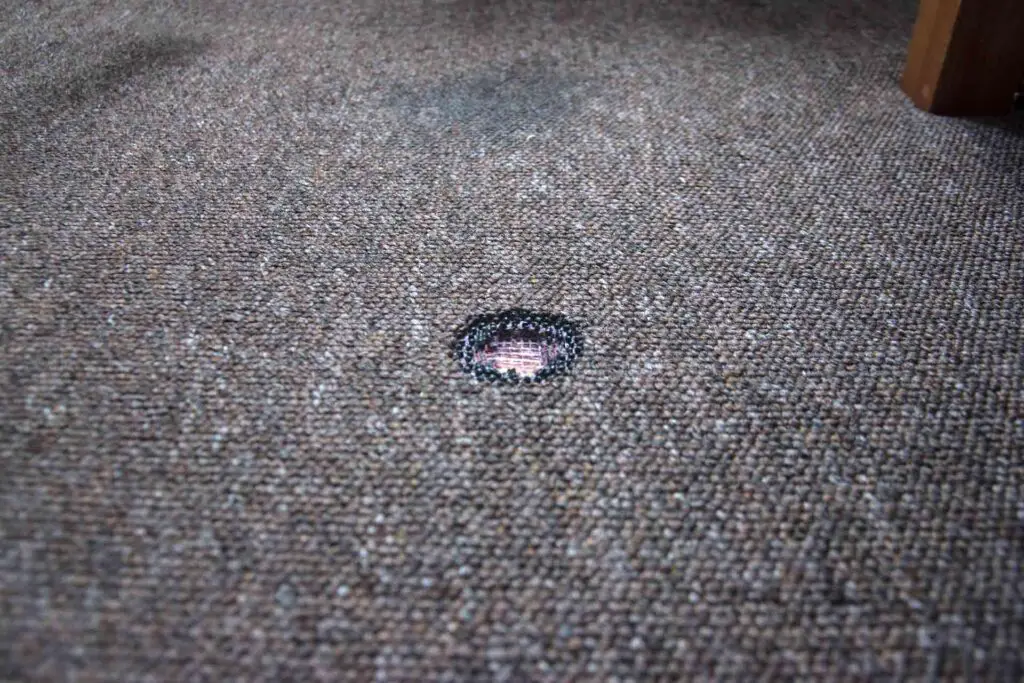
When the hole is smaller than a quarter or roughly an inch in diameter, you can fill it in using individual fibers harvested from an inconspicuous area like a closet corner, under a vent, or behind furniture.
Step 1: Trim Matching Fibers
Use scissors to snip a small amount of carpet fibers from a hidden spot. Be sure to collect fibers that closely match the texture and color of the damaged area. Gently twist or roll the collected fibers to prepare them for insertion.
Step 2: Clean the Damaged Spot
Using tweezers, remove any burnt or loose material from the hole. Use a vacuum to suck out any dust or debris, and ensure the base of the hole is clean and dry. If necessary, trim the edges for a clean work surface.
Step 3: Apply Adhesive Base
Apply a small dot of carpet glue or a hot glue drop into the hole. You want enough to hold the fibers but not so much that it bulges or bleeds through.
Step 4: Transplant the Fibers
Use tweezers to place the matching fibers into the glue one by one, mimicking the original direction and pile pattern. This process requires patience but provides a near-invisible repair when done correctly.
Step 5: Let It Set and Blend
Once dry, use scissors to trim any long fibers, and run your hand over the area to blend it with the surrounding carpet. A light vacuuming can help fluff the area.
Method 2: Carpet Patch from Hidden Area (For Medium Holes)
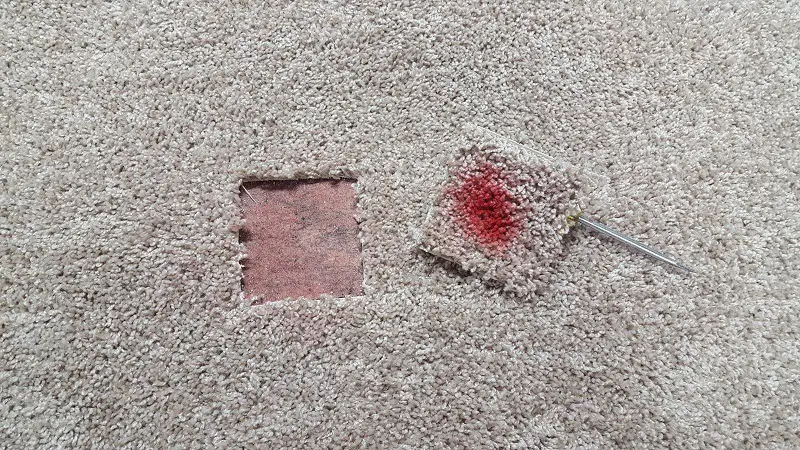
If the hole is larger than 1–2 inches but not overly wide, a small carpet patch from an unnoticeable area can work wonders.
Step 1: Identify a Hidden Carpet Area
Find a section of matching carpet — ideally under furniture, in the back corner of a closet, or from carpet remnants (if you had professional installation). Ensure the donor patch matches the pile direction.
Step 2: Cut Out the Damaged Section
Use a sharp utility knife and a ruler to cut a neat square or rectangle around the hole. Make the cut straight and clean, and save the damaged piece as a template.
Step 3: Prepare the Donor Patch
Trace the cut-out piece onto your donor carpet, then cut the patch using a sharp knife or carpet cutter. Keep the direction of the fibers the same to avoid visual contrast.
Step 4: Install Carpet Tape or Fabric Backing
Place double-sided carpet tape or a thin fabric backing in the hole, sticky side up. Carefully position the new patch over it.
Step 5: Bond and Blend
Press the patch down firmly and use a seam roller or spoon to flatten it into the surrounding carpet. Trim any high fibers, and use a soft brush or vacuum to blend the repair.
Related Topic: How to Get Wrinkles Out of Carpet Without a Stretcher: A Complete DIY Guide
Method 3: No-Patch Visual Blend (For Very Small or Light Damage)

In some cases, where the hole is shallow or barely noticeable, you can make it disappear visually without needing fibers or a patch.
Step 1: Clean and Trim the Hole
Remove any loose fibers or debris and trim the edges of the hole so it’s smooth and flush. If the carpet is matted down, brush the fibers surrounding the hole upward to expose more texture.
Step 2: Use Marker or Carpet Dye
Select a carpet marker or dye that matches your carpet’s color. Gently apply color to the exposed backing or dark area inside the hole. Let it dry completely.
Step 3: Fluff and Distract
Fluff the surrounding carpet fibers and gently rake or brush them to spread slightly over the hole. In some cases, this is enough to conceal the damage unless viewed up close.
Additional Tips to Improve Repair Quality
- Test patch placement: Before finalizing any patch, place it over the hole to see how well it blends.
- Use adhesive sparingly: Too much glue can harden the area and make the repair more visible.
- Recreate pile direction: Fiber direction matters — always match the way your carpet pile lies.
- Trim for uniformity: Once installed, trim any high fibers or uneven areas for a seamless finish.
- Avoid walking immediately: Let repairs cure for at least 6–8 hours before subjecting them to foot traffic.
Related Topic: Tips to Improve Repair Quality
Preventing Future Carpet Holes
A good repair job is only half the battle — prevention is what keeps your carpet hole-free in the future. Here’s how to maintain and protect your carpet:
- Use area rugs in high-traffic areas to absorb wear.
- Trim pet claws regularly and redirect scratching behavior.
- Avoid dragging furniture — use sliders or lift heavy items.
- Clean spills immediately to avoid backing damage.
- Rotate furniture to distribute weight and wear evenly.
Related Topic: How To Avoid Holes In Your Carpet
When to Call in the Pros
If your carpet is badly damaged, or if your repair attempts leave visible patches or seams, it might be time to get help. Professionals can re-stretch, re-seam, or fully replace carpet areas with minimal visibility.
Learn more about our carpet repair services and discover how we can help restore your flooring professionally and affordably.
Final Thoughts
A hole in your carpet — no matter the size — doesn’t have to mean full replacement, even if you don’t have extra carpet lying around. Whether you’re transplanting fibers, patching from a hidden area, or using subtle visual tricks to disguise damage, there’s almost always a DIY solution to restore your carpet’s look.
With the right tools, patience, and attention to detail, you can make those unsightly holes virtually disappear.
For more DIY carpet care tips, tutorials, and flooring advice, visit the Carpet Majesty Blog.

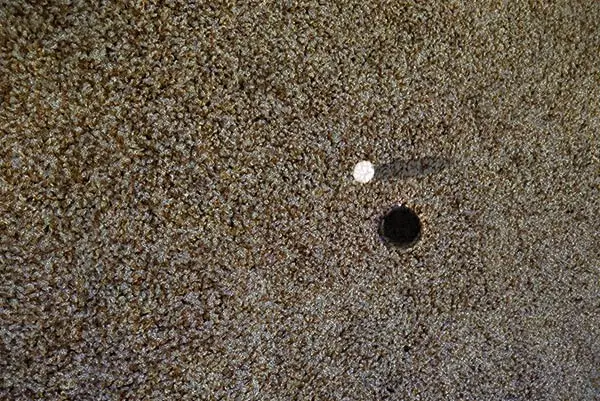
2 thoughts on “Clever Carpet Repair: How to Fix a Hole in Carpet Without Extra Carpet”